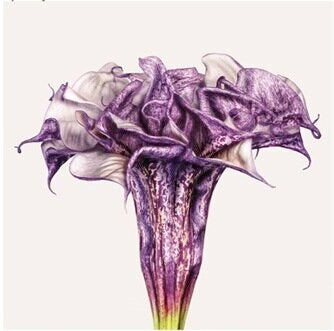The purple Datura flower looks dominant and beautiful, even a little menacing. It dares to stand naked against a stark white void. It has no stem, branch or leaf. Everything is exposed and nothing is hidden. We know that its petals are momentary, so delicate that merely touching them between two fingers will render them non-existent. Yet the confidence with which the Datura projects itself, in such an isolated pure state, demonstrates a rare, compelling power.

This dynamic between the vulnerable and the powerful brings a relevancy to the image of the Datura and other flowers by the New York-based photographer Andrew Zuckerman. The juxtaposition of rigidity and rigour and a fragile, almost feminine form gives these images their distinctive beauty. "Up to now flowers are most portrayed as frilly pretty things, but to me, the flowers I have chosen to shoot are painted as incredibly strong forms, almost architectural," Zuckerman explained to me.
Communicating our vulnerability can also be read as a signal of our inner strength. Last month Antoinette Tuff, the school bookkeeper in Georgia, armed only with her vulnerability, deployed it with extraordinary resourcefulness. Tuff opened up to Michael Brandon Hill, telling him about the break up of her longstanding marriage and the challenges of having a disabled son. She was able to convince Hill, who was brandishing an assault-style weapon with 500 rounds of ammunition, to surrender.
We have also become more willing to invite our friends and a broader public to empathise with our passing moods. Many of us have become blasé about sharing every machination of our internal lives on Twitter and Facebook, which today is actively encouraging us to post how we are feeling. Immersed in a whirlpool of information about our friends' psychological dramas, have we become less quick to judge?
Projecting vulnerability as a sign of strength is not new; it is a theme running deep through Christian iconography and twentieth century Latin American literature and painting. The Mexican painter Frida Khalo for example, placed her own suffering, due to a horrific injury in a bus accident, at the heart of her images, projecting herself with a proud and defiant gaze.
"Since I have had kids, I have become more interested in vulnerable fragile subjects", Zuckerman told me. And his process of capturing the peek moment of the flower's life also demands an unusual degree of care: "From the moment when the flowers were cut to when I received them, it felt like we were handing a Faberge egg or a baby. Everything had to be calm and quiet on the shoots, almost like a surgical operation." Indeed, Zuckerman's studio is said to look like a laboratory. He keeps it crystal clean, which he feels allows him to bring humanity and emotion to the subjects that he captures.

Looking through these images of Zuckerman's flowers, what strikes me is how the medium of photography allows Zuckerman to capture a single moment, in a short life, which is never still or static, and portray it as the totality. "None of these flowers look as good twenty minutes before or after I shoot them. They are shown at their optimum strength, with a robust, often succulent form. I believe that this toughness is integral to the individual flower - it is the environment which in real life compromises it".
In nature, these flowers are not singular and isolated, but flourish briefly as part of a larger ecosystem, which benefits from their fragility and eventual decomposition. But though we know that these flowers are vulnerable, none of these images reveals any weathering, any flaws, or any marks of decay. When we stare at these images, we may be uncertain as to the degree to which they have been manipulated, artificially arranged into a platonic shape, or merely highlighted and exposed against Zuckerman's trademark absence of a backdrop. Has the flower's natural luminosity been revealed in its magnificence, or rather has any weakness or imperfection been airbrushed out?
"I photograph the flowers completely flat with light coming from behind and in front. My direction of light is directionless - coming from everywhere. The flowers exist outside of space so there is no nostalgia, no place and no romanticising." Zuckerman imposes shadows and shading as an after effect to create depth and volume, taking us inside the twists of the petals, inside the three-dimensional form itself. "My intention is to render the truth in a pure way rather like a nineteenth century botanical drawing."
Zuckerman's truth may not be one that a botanist would recognise. The flowers are captured stripped of their environment and mother plant, and often placed at an unnatural angle. However, by choosing to portray the flowers as powerful and strong, Zuckerman is also revealing a deeper truth: The vulnerable have power. In order to portray our vulnerability to others, we have to acknowledge it ourselves, and be brave enough to discard the defences that we habitually use to protect ourselves. But in doing so we open ourselves up to deeper relationships, and can evoke in others as well as ourselves, a broader desire to protect and nurture.
You can hear Andrew Zuckerman talk about his work with Flowers on the BBC World Service ideas show The Forum.
Photographing the Powerful: A piece in which I have explored how the photographer Platon punctures the carefully constructed aura of the power of leaders.